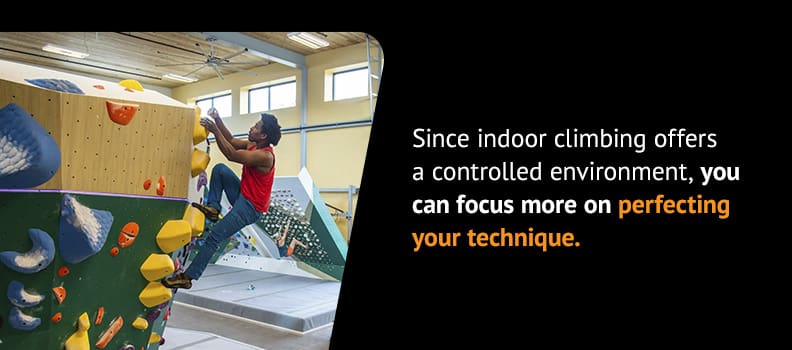Rock climbing is an excellent way to boost your mental and physical strength, but the multiple terms and types can be confusing for some beginners. Let’s compare indoor and outdoor climbing to help you get your climbing journey started.
Types of Rock Climbing
Rock climbing takes place either indoors or outdoors. Let’s look at the different climbing types you’ll come across. Common rock climbing can be categorized into 3 different classifications; Bouldering, Top-Roping, and Lead Climbing. These are the primary types of climbing you will likely experience at an indoor gym, or outdoors at a crag. Additionally, there are less common, and often more dangerous, types of climbing such as ice climbing, free soloing, and multi-pitch climbing.
Indoor Climbing
Indoor rock climbing usually happens inside special-built gyms. These facilities feature engineered textured walls with various heights and angles. The walls are designed to be modular, allowing for interchangeable climbing holds (grips) to be attached virtually anywhere on the walls. The walls can hold enormous amounts of weight and have load bearing anchors that can support sustained use and dynamic loads. These commercial spaces typically have staff and instructors, rental equipment and specific conduct rules to ensure a safe experience for climbers, no matter your ability level. Some enthusiasts build small rock climbing routes inside their homes or garages, but most indoor rock climbing takes place at gyms with the space and funds to support all the sport’s requirements.
- Bouldering: Bouldering indoors or outdoors involves climbing boulders up to 15 feet tall. Bouldering indoors has height limitations because bouldering has no ropes, helmets or other safety gear. Instead, climbers use crash pads to cushion their falls. These shorter routes, also called “ boulder problems,” are often more puzzle-like and allow for more dynamic types of movement. Outdoor bouldering is generally similar to indoor bouldering but sometimes the boulders can run up to 30ft high. This sort of bouldering is called high-balling and is very dangerous even for experienced climbers.
- Top-roping: is climbing up to 50ft (in gym) on a rope that is already attached to the top of the wall, while being belayed by a certified partner below. This type of climbing is available to climbers of any skill level and requires a partner. Belay certification is required prior to climbing in a gym. Belay Classes are offered daily at Momentum, visit our “classes” page for more information or to sign up.
- Lead climbing: Lead climbing is a form of climbing that involves a climber and a belayer and requires more experience and knowledge compared to top-rope climbing. As the climber ascends, they clip into quickdraws—pre-hung carabiners attached to webbing that is fixed to anchor points along the route. If the climber falls before clipping in, they will fall to the last clip below them, which can result in a longer fall and higher risk. Therefore, it is recommended to be comfortable with intermediate top-rope routes before attempting lead climbing. A lead climbing certification is typically required to lead climb in a gym.
Outdoor Climbing
Before the advent of indoor climbing gyms, climbing took place outside on natural rock routes. Outdoor climbing can be more challenging, since it’s on real rock in natural environments and weather. Here are three of the most popular non-bouldering styles of outdoor climbing.
- Traditional climbing: Traditional or trad climbing involves placing and removing your securing hardware, like cams and nuts, as you climb. You have to secure your gear to the wall, trusting your experience and equipment to hold you if you fall. You need advanced climbing skills and a thorough understanding of technique and gear placement to trad climb. This form of climbing is not offered indoors.
- Sport climbing: Sport climbing is generally considered safer than trad climbing since the bolts are already fixed to the rock face. It’s essentially outdoor lead climbing. As you climb, you clip your rope and quickdraws into the installed bolt hangers up the wall, letting you focus on your movements instead of worrying about gear placement.
- Multi-pitch climbing: Multi-pitch climbing involves ascending a route longer than a single rope length, typically 50-70 meters. Since the lead climber can’t complete the climb in a single pitch, they must make one or more stops at belay stations. The lead climber ascends a pitch, builds an anchor, and then belays their partner up. These routes can be several thousand feet high and may require multiple days to complete, necessitating camping on the wall, suspended hundreds of feet in the air.
- Free Solo climbing: Free soloing is the most extreme type of climbing and is not recommended. Free soloing means you climb with no harnesses or other gear — just your body holding you to the rock. With no protection, climbing routes that can be thousands of feet high where any mistake or fall is likely fatal. Very few people free solo climb, as it’s much riskier and requires years of practice and mental strength. Even the best climbers in the world can die while soloing because there are many factors out of human control such as a rock breaking off.
Indoor vs. Outdoor Climbing
Indoor and outdoor climbing share a lot of overlap, but they also differ in many ways. Understanding what you need for each category will help you pick the right style and stay safe while you climb. It is recommended to learn to climb indoors by certified instructors before venturing into outdoor climbing where the risk factor is exceptionally greater for the inexperienced.
1. Climbing Locations and Environments
With indoor climbing, there’s no real rock, and you don’t have to worry about changing weather conditions. Artificial routes change regularly and usually have brightly colored plastic or fiberglass holds, making them easier to climb on sight. They’re accessible year-round and often feature top-roping, bouldering and lead climbing areas.
Indoor and outdoor routes have grades that tell you how complex they are. However, the elements can make an outdoor route harder or easier, depending on the day. When you climb outdoors, you climb on natural rock formations that remain the same for years. You need to understand the risks of nature and stay alert, as outdoor climbing features more challenges and variables.
2. Climbing Techniques

Since indoor climbing offers a controlled environment, you can focus more on perfecting your technique. Indoor gyms have dedicated employees who create routes to emphasize strength, technique, endurance, problem-solving and balance. You get to practice on consistent surfaces, giving you a safe training ground to improve and exercise on.
Outdoor climbing means doing some research and applying lots of techniques at once. You must find routes with grades in your desired range or style. You should also prepare to encounter natural rock features, like jugs, crimps, slabs and overhangs. Rock is more unpredictable than indoor routes, so you need to learn to read the rock and use different techniques to ascend successfully. Additionally, outdoor often features more complex techniques like crack climbing and chimneying, which are less common indoors. You must also thoroughly research the outdoor area’s rules, regulations and etiquette prior to climbing.
3. Climbing Gear
Indoor climbing is more approachable and convenient. You only need shoes, a harness, a belay device and a chalk bag. Some gyms will even rent all this equipment to you. They also provide crash pads for bouldering. If you’re lead climbing, you’ll need a dynamic lead rope and possibly other gear such as quickdraws.
Outdoor climbing means bringing supplies tailored to the climbing you’re doing. Along with basic gear, you need rope, helmets, crash pads, rope bags, multiple pairs of shoes and a guidebook for the area. Trad climbers also need cams and nuts, carabiners and slings. Additionally, outdoor gear must withstand the wear and tear of harsher weather conditions.
4. Safety Measures
Indoor climbing gyms have strict safety requirements for their customers. They regularly inspect and maintain routes and gear to protect climbers. Trained staff members are on hand to monitor and warn you if you do something dangerous. Additionally, there is a padded floor to prevent fall injuries. It’s a highly controlled environment, offering more safety than outdoor spaces.
Outdoor climbing is riskier, thanks to unpredictable conditions. Climbers are responsible for their safety — they must check the weather, routes and gear to prevent accidents. Climbing outdoors means investing in safety gear like helmets, proper anchoring and good belay technique.
5. Climbing Training and Strength Building
Indoor gyms often have training equipment so you can focus on specific exercises and skills. Gyms also offer classes to teach proper form and technique. In contrast, outdoor climbing involves training through real-world practice. Climbers use different rock types and routes to strengthen their abilities.
Frequently Asked Questions
Here are answers to some of the most commonly asked questions to help you start climbing.
Can You Get Fit by Indoor Climbing?
All rock climbing is exercise. Whether you’re climbing indoors or outdoors, you can get an excellent full-body workout as you climb. Climbing builds strength, flexibility, endurance and balance, making it a great choice for anyone looking to start working out. Additionally, many indoor gyms have fitness equipment and climbing training stations, letting you focus on specific exercises.
Can You Rock Climb Alone Indoors?
Yes, you can rock climb alone indoors. Bouldering and auto-belay sections do not require partners. If you’re a solo climber, going to an indoor gym lets you try new skills and make friends in a safe environment. However, for safety reasons, you should always climb outdoors with a partner who can support you in case of an accident.
Do I Need Shoes for Indoor Rock Climbing?
You need to wear shoes while indoor rock climbing. Climbing shoes improve your performance by molding to your feet, boosting your precision on the wall. Additionally, they are more hygienic in an environment where everyone repeatedly uses the same holds. Outside, you can choose to go barefoot if you like, though you’ll protect your feet and climb better with shoes. Climbing shoes are always recommended for a better experience.
Try Indoor Climbing at Momentum

Take your fitness to new heights and discover endless adventures at Momentum’s indoor climbing gyms. With locations in Utah, Texas and Washington, Momentum offers a community for climbers of all types and styles. Our team works to challenge your skills, helping you grow physically and mentally. Whatever your climbing level, Momentum is here to empower you. Improve your rock climbing and make new friends at a Momentum Climbing gym near you!


